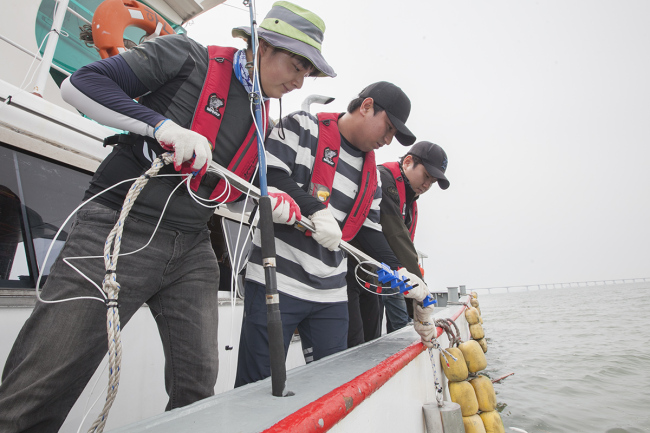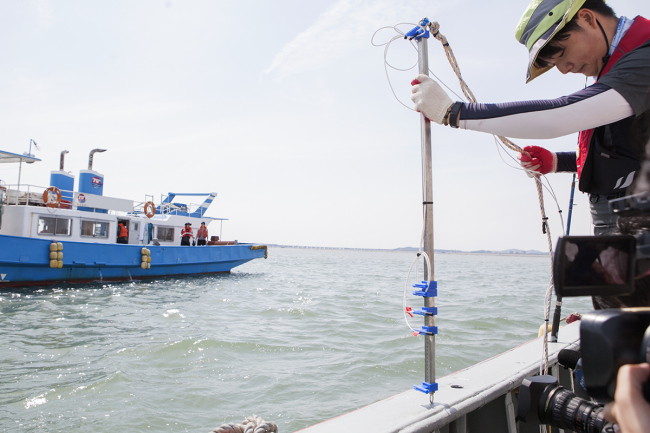INCHEON – A text message is sent from a boat floating about 800 meters off from another one carrying a group of journalists in the waters about 10 kilometers west of the Port of Incheon on Tuesday.
“I am hungry!”
The message was successfully received by a hydrophone installed 25 meters underwater by a research team led by Ko Hak-lim, professor of oceanic marine IT convergence technology at Hoseo University.
It took about 20 seconds to transfer the message through the long term evolution network operated by South Korea’s leading mobile carrier SK Telecom.
“I am hungry!”
The message was successfully received by a hydrophone installed 25 meters underwater by a research team led by Ko Hak-lim, professor of oceanic marine IT convergence technology at Hoseo University.
It took about 20 seconds to transfer the message through the long term evolution network operated by South Korea’s leading mobile carrier SK Telecom.

“What we do here is to realize a so-called underwater IoT network, and Korea will be the first in the world to establish an adaptive underwater wireless network,” said Ko. “Once we build the network here in the West Sea of Korea, which is infamous for its turbulent sea currents, the technology will be applicable to any part of the oceans, and will endure strong currents.”
The scholar’s team is in the third year of working on this underwater project with SK Telecom, developing a communications system connecting an underwater station with an offshore buoy. The project was commissioned by the Ministry of Oceans and Fisheries.

The buoy is supposed to control the underwater station and send the signals from the waters to SKT’s onshore network.
In the current stage, the joint team has succeeded in sending and receiving text messages, low-resolution pictures and real-time data about water temperatures, sea currents, salinity, submarine earthquakes and tsunamis, which are collected from underwater sensors via a pilot network.
The team aims to embark on construction of a test bed for the underwater network this October and complete by 2020.
“We plan to install a number of underwater stations with a diameter of 1 kilometer in multiple areas that are in need of communications for economic and security purposes,” the professor said. “The underwater LTE network can be widely applied to issuing early warnings for oceanic disasters such as tsunamis, protecting fisheries, monitoring the submarine environment and detecting glitches in deep-water oil drilling, and so forth.”
There have been active studies and research on submarine communications technologies in countries like the United States, Europe, China and Canada. However, most of them have been limited to fixed-line networks, according to SKT.
“SKT is the only firm in the country with the technologies to design LTE networks for public protection services, railroads, maritime facilities and submarine resources,” said Park Jin-hyo, head of network technology institute of SKT.
By Song Su-hyun (song@heraldcorp.com)
-
Articles by Korea Herald





![[Herald Interview] 'Amid aging population, Korea to invite more young professionals from overseas'](http://res.heraldm.com/phpwas/restmb_idxmake.php?idx=644&simg=/content/image/2024/04/24/20240424050844_0.jpg&u=20240424200058)


![[Pressure points] Leggings in public: Fashion statement or social faux pas?](http://res.heraldm.com/phpwas/restmb_idxmake.php?idx=644&simg=/content/image/2024/04/23/20240423050669_0.jpg&u=)











